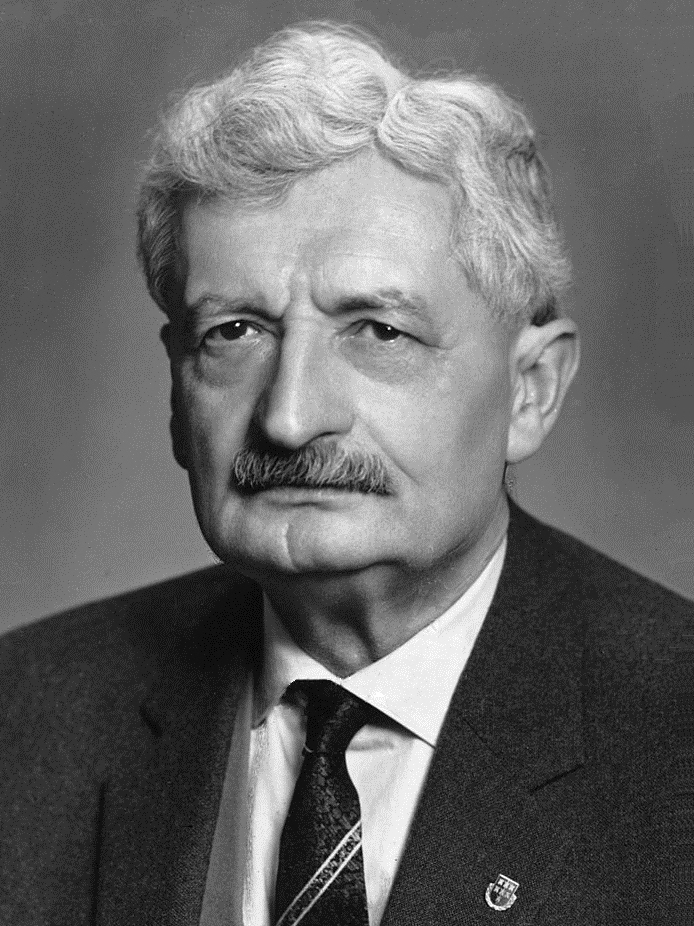The ‘Father of Space Travel,’ he wrote visionary books on man’s future in space.
Hermann Oberth was born on June 25, 1894, in Hermannstadt, Austria-Hungary (now Sibiu, Romania). He was a German scientist who was one of the founders of modern astronautics and is sometimes called “the Father of Space Travel.” He is often compared to Robert Goddard of the United States and Konstantin Tsiolkovsky of the Soviet Union.
The son of a prosperous physician, Oberth’s interest in space travel began when his mother gave him two books of Jules Verne, From the Earth to the Moon and Journey Around the Moon, at the age of eleven. Three years later he designed his first spacecraft. Oberth enrolled in the University of Munich in 1912 to study medicine, but his education was interrupted by service as a medic in the Austro-Hungarian army during World War I.
After being wounded in combat, Oberth pursued his old dream of flight. He conducted experiments to simulate weightlessness and designed a long-range, liquid-propellant rocket that he submitted to the German War Ministry in 1917, but his ideas were rejected. After the war, Oberth sought a Ph.D. degree from the University of Heidelberg, submitting a dissertation based on his rocket design. It too was rejected, but Oberth partially underwrote publishing expenses, and his dissertation appeared in 1923 as the book Die Rakete zu den Planetenräumen (The Rocket into Interplanetary Space). In it, he explained mathematically, how rockets could achieve a speed that would allow them to escape Earth’s gravitational pull. The book earned Oberth widespread recognition and inspired a generation of German rocket enthusiasts.
Until 1922, Oberth was unfamiliar with the work of Robert Goddard in the United States and until 1925, with that of Konstantin Tsiolkovsky in the Soviet Union as well. After corresponding with both men, he freely acknowledged their precedence in deriving the equations associated with space flight. In 1929, Oberth’s Wege zur Raumschiffahrt (Ways to Spaceflight) won the first annual Robert Esnault-Pelterie-André Hirsch Prize, enabling him to finance his research on liquid-propellant rocket motors. In the book, Oberth anticipated by 30 years the development of electric propulsion and of the ion rocket. The same year he joined the world’s largest rocket society, at the time, the Verein fur Raumshiffahrt or VfR (“Spaceflight Society”), and was soon voted its president.
In September 1930, Oberth took a teaching post in Romania and in 1931, received a patent for a liquid-propellant rocket from the Romanian Patent Office. He then returned to Germany, and with his teen-aged protégé Wernher von Braun and other members of the VfR, launched Oberth’s first rocket on May 7, 1931, near Berlin (more than five years after Goddard launched the world’s first liquid-fuel rocket).
In 1938, Hermann Oberth joined the faculty of the Technical University of Vienna, then transferred to the Technical College in Dresden. Oberth became a German citizen in 1940, and in 1941, transferred to the German rocket development center at Peenemünde, where he worked for Wernher von Braun in constructing the world’s first modern war rocket, the V-2, which was used against primarily civilian targets in World War II.
Later in the war, Oberth worked at Wittenberg, Germany on solid-fuel rockets for air defense. With the collapse of Nazi Germany and the beginning of the Cold War, he fled to Feucht, in western Germany. By 1948, Oberth was working as an independent consultant in Switzerland and then on solid-fuel rockets in Italy in 1950. In 1953, Oberth returned to Feucht to publish his book Menschen im Weltraum (Man in Space), in which he detailed advanced ideas space stations, electric spaceships and space suits.
After World War II, Wernher von Braun and much of his V-2 team had been taken to the United States and eventually helped establish an American Institute for Space Exploration in Huntsville, Alabama. He was able to entice his mentor, Hermann Oberth to join him there in 1955 to pursue rocket studies in the Technical Feasibility Studies Office of the U. S. Army Ordnance Missile Laboratories. In 1956, Oberth transferred to the Army Ballistic Missile Agency as chief of Special Fields in the Research Projects Office. He resigned from U.S. government service in November 1958 and returned to Germany.
From 1960 until his retirement in 1962, Oberth worked for Convair as a technical consultant in the development of the Atlas rocket for the United States. Turning to more philosophical concerns in his later years, he wrote the books Matter and Life and Catechism of the Uranics, and in 1984, Primer For Those Who Would Govern.
On December 28, 1989, Hermann Oberth died at the age of 95, in Nuremberg, West Germany. The Oberth lunar crater and Asteroid 9253 Oberth are named in his honor, as is the Hermann Oberth Raumfahrt Museum in Feucht.
Years before, Von Braun had paid tribute to Oberth’s accomplishments:
“I have a boundless admiration for the solitary genius which enabled him to bring into focus all of the essential elements of a gigantic concept, together with the human greatness which allowed him, in shy reserve, to bear with equanimity the “crucify him” as well as the “hosannas” of public opinion. I myself owe him a debt of gratitude not only for being the guiding light of my life but also for my first contact with the theoretical and practical aspects of rocket technology and space travel.”

